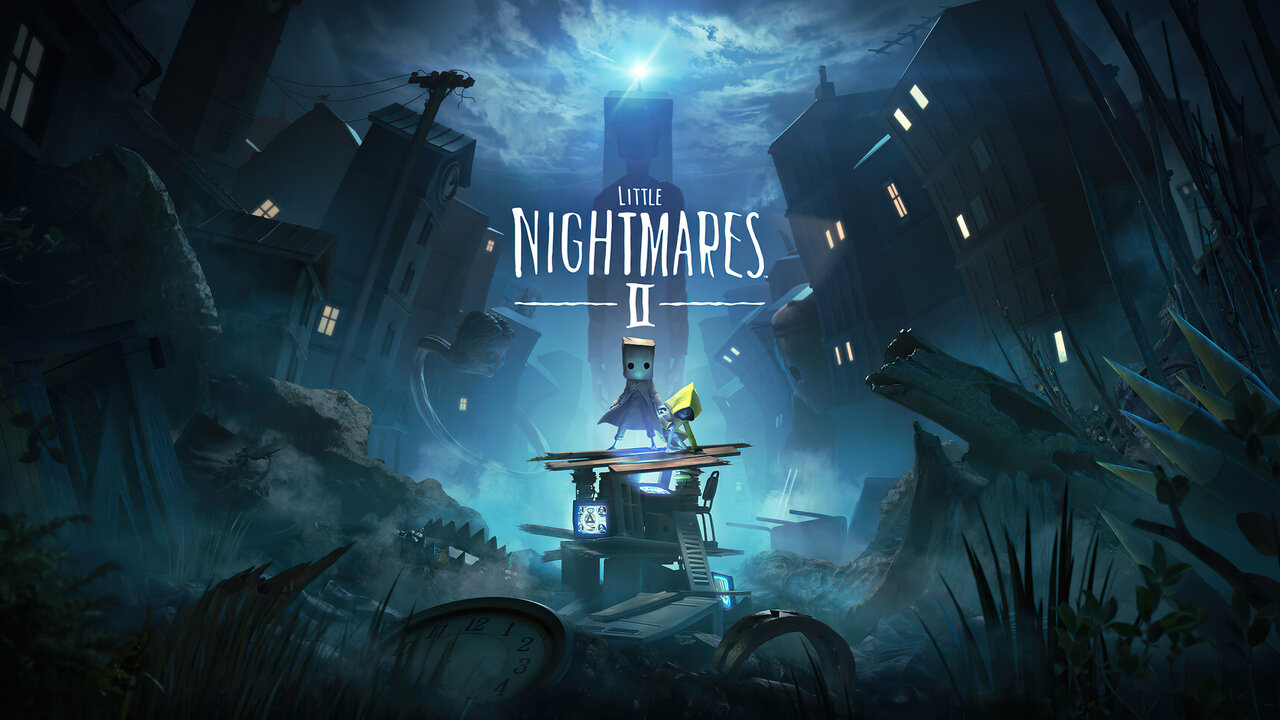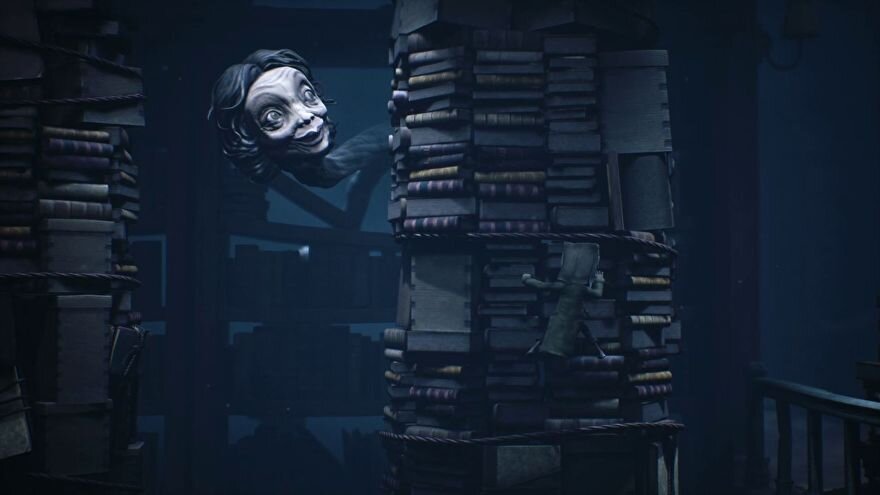Little Nightmares II Review
Walking through a Nightmarish Wonderland
Developed by: Tarsier Studios
Published by: BANDAI NAMCO Entertainment
Available on: Xbox, PS4/5, Nintendo Switch, Stadia, and PC
Materials & Methods
Reviewed on the Xbox Series X
Introduction
Horror games have always been hit or miss. While nearly everyone has a scary moment here or there, not many truly capture the fear or suspense of doing everything you need to survive. Those who do achieve this never seem to find the right balance between “scaring the player” or “being merciless to the player.” You either are always on edge because something is behind you at all times chasing you down, or you’re just getting jump scared with the threat of death being very minimal. Some even take it one step further. The danger is always present until you get the best weapons late-game. What about those smaller, less ambitious games but still carve their way into the horror genre? That’s where Little Nightmares comes into play. Developed by Tarsier Studios, Little Nightmares has made its own niche, and I’m so glad it did.
Little Nightmares, released in 2017, is a puzzle platform horror game that puts you in the shoes of Six, a little girl who wakes up on a boat filled with threats around every corner ready to eat her. There were hints of other young life in the original game which had some semblance of humanity. Still, there wasn’t much else we saw beyond the walls of The Maw. Several years later, we get a taste of the outside world with the mobile game Tiny Little Nightmares, where we see Six's earlier days and how dangerous the bigger world is, even if it all takes place in a mansion. Then, in 2019, a full sequel was announced. With love for the first game only growing over time, its sequel was set up to run right out of the starting block.
Personally, I had little interest in the series… until about a week before launch. All I’ve seen of the first game was that image of a person hanging from a chair as a little child acts like nothing is wrong. It put a bad taste in my mouth. As I saw the hype build for Little Nightmares II and the previews start to post, something changed. I downloaded the game off of Game Pass and jumped right in. It was like something switched to “On” inside of me. It only took an hour of playing Little Nightmares for me to get hooked. I fell in love with the whole universe of Little Nightmares, from the world-building to the atmosphere, the creepy adults, and the mystery of how this dilapidated world got to be so cursed. I wanted to know more! Several hours, three DLCs, and one mobile game later, I could not wait for the upcoming release. That hype was not let down at all either. Little Nightmares II is everything a sequel should be! Now, let’s delve into the darkness and talk about how Little Nightmares 2 shined, how it faltered, and how it set the standard for what we should expect in future game iterations.
Results & Findings
Similar to Tiny Little Nightmares, Little Nightmares 2 doesn’t put you in control of Six. Rather, another child trying to help Six survive. This time you control Mono, a boy who wears a bag over his head wakes up in front of a TV in a dark forest. While exploring, he finds out that this isn’t any average forest. There are traps littered throughout with cages full of bodies holding fresh and old prey. Of course, in this universe, these aren’t animals captured, but humans. After surviving the forest, Mono comes across a log cabin that has its own terrors. Disgusting food from unknown origins, a family eats dinner, but the family members are taxidermied out of different skin pieces and a child trapped in the basement. A recent catch appears to be receiving preferential treatment as they await their fate. This child is who veterans will recognize as Six.
Six and Mono team up to escape this nightmarish cabin, and after a narrow escape with a hunter who also wore a skin face mask, Six and Mono sail across the sea on a door to the Pale City, the main setting of this game. Little Nightmares II adds so much lore to this growing hellscape of a world. When it was just believed to be a boat, we see a whole city of evils, monsters around every corner ready to capture and eat these two. What’s amazing about Little Nightmares II is that it finds time to show the city's integral portions and how they have become. From a school full of doll children taught by a teacher who tries to see everything going on, to a hospital with a doctor that only seeks perfection by deforming his patients with mannequin limbs, to apartment complexes full of faceless people who are obsessed with their TVs and will attack anyone if their TV turns off, nowhere is safe for this duo. What’s most impressive is just how detailed each area is. No two chapters look or feel the same. Additionally, it’s the addition of extra threats in each chapter that takes this game to the next level and REALLY makes it feel like a full-blown sequel.
I absolutely adore how different levels feel, particularly because you start to get used to one threat, know how to stop them, then a whole different one appears that you must now strategies for in a short time to keep progressing. Let’s take the school for example. Just about every chapter is divided up into two parts. The first part can be summarized as the “minion phase.” There’s a lot of minions or little monsters in an area. For the school, it’s a lot of porcelain dolls that are alive and acting like rowdy school children. When not being taught by the teacher, they are wreaking havoc throughout the halls. They even went as far as setting up booby traps that look like escalated pranks gone wrong. A prime example being a locker that comes swinging down, ready to hit anyone in the head. Then about halfway through, there is a shift. Now your only threat is the teacher who stalks the halls trying to find mischief while also trying to conduct her own prep work. Each level has this tonal shift while keeping the essence of the chapter that really feels like it adds longevity to the levels in the best ways. Once you understood what to do for a “baddie,” you knew how to survive the chapter in the first game. In this one, however, it’s keeping you on your toes in all the best ways.
I was most pleased about how much better it felt to control Mono and Six than in the first game. Gameplay-wise, Little Nightmares II plays very similarly to the first iteration but with many quality of life improvements. First is the use of Six and Mono. While you only control Mono, Six acts like a second player through her intelligence. She knows how to avoid danger, and she will act quickly to help you in sticky situations. Six will run to an item to push it with you or stand by a large wall to fling you up without any prompts. Six is everything you’d want in a co-op partner if another player-controlled them. Six will never let you down….
Movement and controls thankfully feel smoother to a degree. This requires a little bit of an explanation. The controls are not perfect by any means, but they work well in the context of the Little Nightmares universe. Mono does not turn on a dime. But, veterans of Little Nightmares will be happy to know that Mono is very responsive to commands. Grabbing things is much easier; running around tight hallways to avoid chasing enemies is less frustrating, and carrying keys doesn’t take up your hands. Additionally, running along poles or tight spaces change how Mono walks across them, so you don’t accidentally step off. There’s so many minor quality of life updates like those listed above littered throughout this 4-5 hour experience. Just about every update made to create Little Nightmares II is exactly what I look for in a sequel.
There are some downsides, though, particularly with some of the new mechanics introduced, that I found to be a toss-up for my own enjoyment. In each level, there’s a different mechanic that tries to shake up the gameplay specifically for the threats you’re about to face there. For instance, the biggest change is having a companion. You play through half a chapter of learning how Six can help you; then the next area adds combat. While it only plays a part for half of a chapter, it is very frustrating. It is a one-hit-and-you’re-done type of scenario. Mono is slow with the weapons you’re given to use, from a fire ax to a lead pipe which is twice the size of him, and the enemies are quick. The little porcelain school children you’re facing are trying to pounce you to bully you and Mono. It takes a fast reaction that requires almost perfect accuracy and reaction times to get right. Swing too soon, and the doll won’t be in their leap to be hit. Swing too late, and you’ll get grabbed. If you mess up, you have to redo the whole room again. On another level, some mannequins come alive in the darkness. You can stun them with a flashlight and sneak by before they capture you. I found the flashlight to be more annoying than difficult to control, which led to my death several times only because I couldn’t get it to point at the enemies numerous times, but rather it pointing at the floor or the ceiling. They are great ideas in practice, and I get that there has to be that sense of urgency because it is a horror game, but there is a balance between difficulty and clunkiness that I don’t think is well achieved in some parts of the game.
Now I want to touch on the ending quickly. Without spoilers, the ending is a major event that tries to set up more in the world while keeping things wrapped up in a very nice package. It’s beyond frustrating what happens, but it feels EARNED! I’ve played many games where the rug is pulled out from under you and feels so dissatisfying to watch. What I love about the Little Nightmares franchise is that you feel so emotionally invested in the characters you control in a few short hours. But this may be the end of Little Nightmares as we know it. Tarsier Studios will no longer be the studio working on Little Nightmares as BANDAI NAMCO is the license holder. But, if this is how the series ends, it’s a damn fine game to see it out.
Discussion
Little Nightmares II is the prime example of what a sequel should strive to be. It raises the bar with its storytelling, its gameplay changes, and how it adds to the overall picture. Throughout the 4-5 hours of game time, I felt drawn into the story of Mono and Six’s fight for survival in a darker world than what was introduced in Little Nightmares. Tarsier Studios has a gift with its storytelling and worldbuilding. For a smaller team, they create such an engrossing world that has made me want to know more. Seriously, I’ve been watching theory videos nonstop since playing these games. Regardless of what you think of horror games, the entire Little Nightmares series should be your next-played game on your list.








